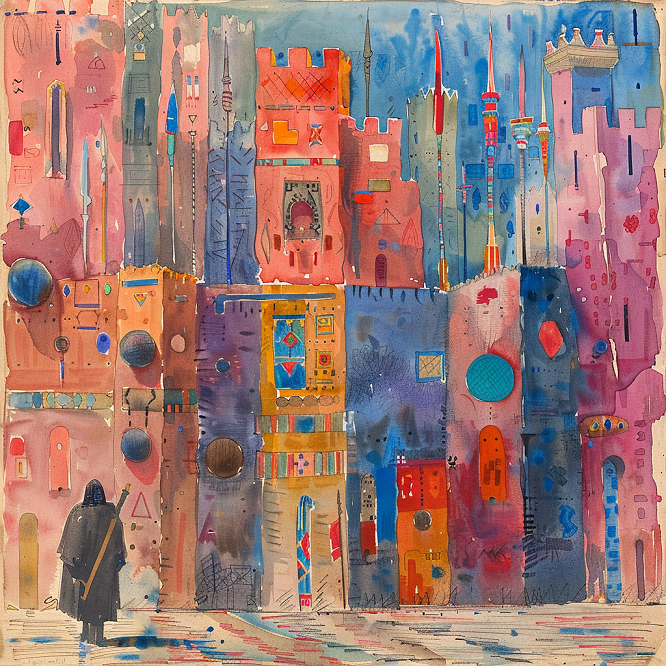Lady Anne Blunt, a notable writer and traveler, recounts her experiences in her book, Pilgrimage To Nejd, providing a unique perspective on the culture and society of Nejd in the late 19th century. Through her detailed observations and interactions with the locals, Lady Anne Blunt’s books offer readers a glimpse into a world filled with intrigue, hospitality, and contrast.
Women of Ha’il
Within the finely woven narrative of Pilgrimage To Nejd, Lady Anne Blunt provides personal and vivid accounts of her encounters with the women of Nejd society. A particularly heart-warming interaction was with an affectionate mother named Beneyeh. Beneyeh’s pride for her son Abdallah, who was merely four months old at that time, is mentioned as a proud display of maternal love in a society where strength and resilience marked everyday life. Alongside Beneyeh, her sister too, though less prominently featured, was depicted as endearing and anxious.
An alteration in course led to Lady Anne parting ways with Beneyeh’s sister, whereupon she was taken to the apartment the second wife of a Shammari notable, Zehowa. Introduced as the daughter of Telldi, Zehowa is a character that comes through as highly sympathetic and astute. Her own motherhood to her nine-month-old daughter brought another dimension into the dynamic tapestry of Nejd’s familial patterns.
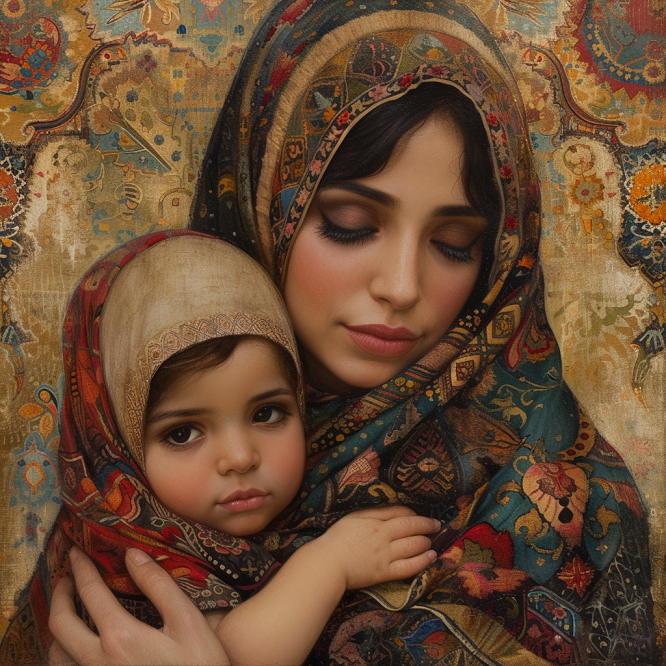
Zehowa sent for her daughter, a baby only nine months old, to show me, and I told her I had a daughter of my own, and that girls were better than boys, which pleased her, and she answered, “Yes, the daughter is the mother’s, but the son belongs to the father.”
Pilgrimage To Nejd: Lady Anne Blunt
Through her astute observations, Blunt described Zehowa as a woman of intelligence and warmth, engaging her in several heartfelt conversations. The bond between the two women was such that before parting, Zehowa, moved by the depth of their shared experiences, plaintively urged Lady Anne to return or at least visit again as soon as possible. The notion of shared humanity, irrespective of the vast differences in their worlds, comes through with palpable poignancy in Lady Anne’s account of her encounter with Zehowa.
Mubarak and Suleyman’s Family
Continuing her journey through Nejd, Lady Anne Blunt added further depth to her narrative with her encounter with Mubarak. As the chief of the slaves, Mubarak’s unique perspective and intimate knowledge of the local equine culture provided crucial insights to Lady Anne’s husband, Wilfrid. Blunt distinctly highlights Mubarak’s role in educating Wilfrid about Feysul ibn Saoud’s notable stable of horses, thus enriching the overall scope of their understanding of Nejd’s intricate societal structure and culture.
The narrative then transitions to Lady Anne’s visit to the harem of Hamud’s uncle, Suleyman. Here, she was greeted by Suleyman’s wife, Ghut. Ghut was presented by Lady Anne as being talkative and hospitable, albeit a bit dull. However, it’s her daughter, Zehowa, who added a new layer of intrigue to the narrative.
Zehowa, who notably shares a name with Hamud’s second wife encountered by Lady Anne earlier, added a unique dynamic to her understanding of the Nejd society. She was a mother to a child named Abderrahman, reflecting a recurring theme of motherhood in Lady Anne’s encounters.
The conversation was dull. Here is a sample :
I. ” What do you do all day long
Zeh. “We live in the kasr.”
I. ” Don’t you go out at all ? ” Zeh.” No ; we always stay in the kasr.”
I. ” Then you never ride” (I always ask if they ride, to see the effect) ” as we do”
Zeh. ” No, we have no mares to ride.”
I. ” What a pity ! and don’t you ever go into the country outside Hail, the desert ?”
Zeh. “Oh, no, of course not.”
I. “But, to pass the time, what do you do ?”
Zeh. ” We do nothing.” Here a sharp black boy interrupted us, ” 0, khatun, these are daughters of sheykhs, they have no work —no work at all to do, don’t you understand ?”Pilgrimage To Nejd: Lady Anne Blunt
I. ” Of course, I understand perfectly; but they might amuse themselves without doing work,” and turning to Zehowa I added, ” Don’t you even look at the horses ?”
Zeh. “No, we do nothing.”
Through various conversations with Zehowa, a vivid picture of the sedentary lifestyle of women in the harim was painted. Lady Anne Blunt’s attention to these details offered readers an unparalleled window into the daily lives and experiences of women in Nejd. These encounters, through her keen observation and respectful engagement, managed to peel away at the multiple layers of Nejd society, revealing its complex depths to readers from afar.
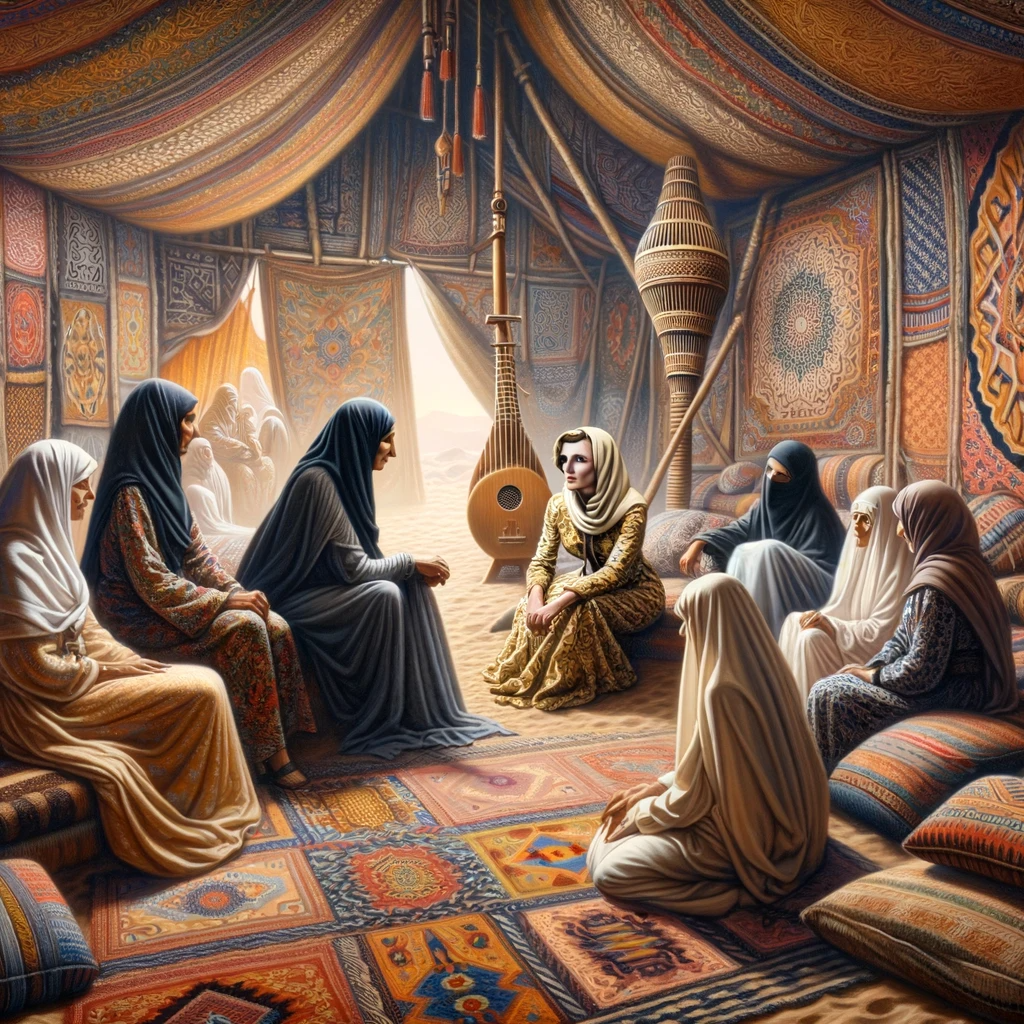
Intrigue and Pressures
As Lady Anne Blunt navigated her way through the intricacies of Nejd society, her account in Pilgrimage to Nejd also reflected the undercurrents of intrigue and pressures that seeped through the journey. Despite their attempts to remain unobserved and respectful of local customs, the network of mystery associated with the foreign travelers began to exert a certain strain on the party. Her narrative moves from the understanding and sympathetic Zehowa to the more challenging scenarios of trying to maintain a delicate balance between observation and intervention.
In her recounting of time in Nejd, Lady Anne and her companions often found themselves spending evenings with the Emir, a testament to their recognition and the hospitality extended to them. Notwithstanding the warmth and hospitality they encountered, the long shadow of international politics and local disputes did make its presence felt. News from the outside world seeped through the fabric of their journey, bringing with it tales of battles and betrayals.
A crucial event was the arrival of news from El-Homeydi ibn Meshur, a Roala sheykh, who had engaged in a battle against Sotamm of the Welled Ali. Even as the pressures of larger conflicts remained at a distance, the impact of these occurrences was evident in the tensions that crossed tribal territories and echoed in the conversations within the adobe walls. The defeat of Sotamm’s forces was a significant event that sent ripples through the region and added to the atmosphere of impending change.
Sotamm, at the head of a ghazu (raiding party) numbering six hundred horsemen, had marched against Ibn Smeyr at Jerud, but the latter refused to come out and fight him, and so Sotamm retired. On his way back home, however, he fell in with an outlying camp of Welled Ali, somewhere to the east of the Hauran, and summoned it to surrender. These, numbering only a hundred and fifty horsemen, at first entered into negotiation, and, it is said, offered to give up their camp and camels if they were permitted to retire with their mares (the women and children would of course not have been molested in any case), and to this Sotamm wished to agree.
But the younger men of his party, and especially the Ibn Jendal family, who had a death to avenge, would not hear of compromise, and a battle ensued. It ended, strangely enough, in favour of the weaker side, who succeeded in killing four of the Roala, and among them Tellal ibn Shaalan, Sotamm’s cousin and heir presumptive. Sotamm himself is said to have been saved only by the speed of his mare. Though the forces engaged were so disproportionate, nobody here seems surprised at the result, for victory and defeat are ” min Allah,” ” in the hand of God;
Pilgrimage To Nejd: Lady Anne Blunt
In this section of her journey, Lady Anne Blunt’s narrative shifts from the microcosm of family interactions to the macrocosm of tribal politics and power games, broadening the scope of the narrative. These unfolding events further entrench the historical significance of Lady Anne Blunt’s Pilgrimage to Nejd, drawing into focus the broader geopolitical landscape of 19th-century Arabian Peninsula as glimpsed through the experiences of a single, intrepid traveler.
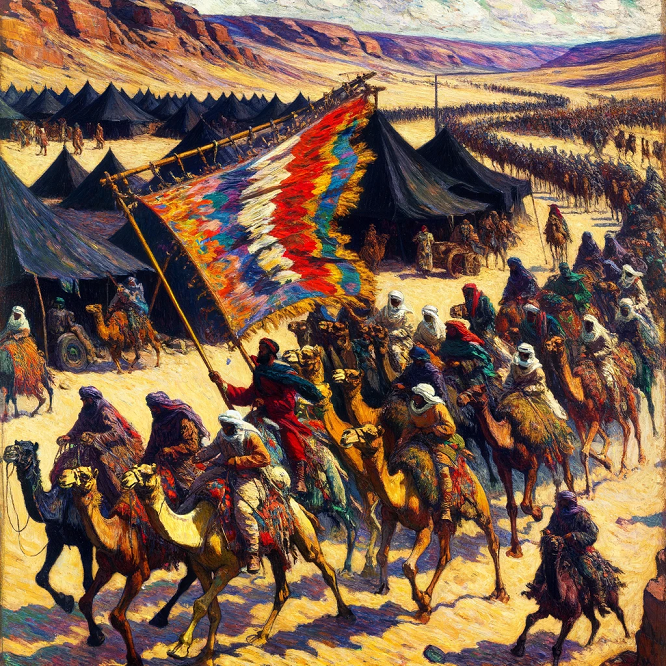
Conversations with the Emir and Nassr ibn Hezani
As Lady Anne Blunt delved deeper into the society of Nejd and its shifting dynamics, her interactions widened to include influential figures. Her conversations with the Emir form a significant part of her omnibus Pilgrimage to Nejd. In these shared dialogues, Lady Anne provided a dazzling perspective on various influential tribal sheykhs, showcasing her admiration for figures such as Mohammed Dukhi, Ferhan ibn Hedeb, and Faris Jerba. These sheykhs, each powerful in their own right within the Bedouin society, are portrayed in an admirably light by Lady Anne, thus underscoring her broad-mindedness and appreciation of the cultural fields outside her native sphere.
While her appreciation for their culture and society was evident, so was her passion for horses. This is depicted in an interesting conversation between Lady Anne and the Emir concerning different horse breeds and their respective steeds. This shared love for equine lineage appears to have forged a stronger bond between them, transcending the cultural and social barriers that lay between a Bedouin Emir and a British woman in the 19th century.
We then talked a good deal about horses, and our knowledge on this head caused general astonishment. Indeed, I think we could pass a better examination in the breeds than most of the Ibn Rashids. By long residence in town they have lost many of the Bedouin traditions.
Pilgrimage To Nejd: Lady Anne Blunt
Joining this charismatic cast of characters in Pilgrimage to Nejd was a man named Nassr ibn Hezani. Nassr, hailing from Southern Nejd, might have appeared unassuming on the surface, yet the depth of respect he garnered from his peers was indicative of his esteemed position within their society. Conversations with and about Nassr reveal many intriguing facets of his character, including a prior quarrel with Ibn Saoud and his aversion to smoking, a rather unusual trait that ran against the popular practices of his time. Furthermore, Nassr’s clear distaste for Wahhabi practices provided further insight into the complex web of differing philosophies existing within the tribal society.
It is not the custom of Hail to smoke, either from Wahhabi prejudice, or, as I am more inclined to think, because tobacco has never penetrated so far inland in quantities sufficient to make the habit general. No objection, however, has been made to Wilfrid’s pipe, which he smokes when and where he chooses, and this evening when the call to prayer sounded, and the Emir and Hamud had gone out to perform their devotions, the old man I have just mentioned, Nassr ibn Hezani, hinted without more ceremony that he should like a whiff.
He has quarrelled with Ibn Saoud, and probably hates all the Wahhabi practices, and was very glad to take the opportunity of committing this act of wickedness. He was careful, however, to return the pipe before the rest came back. He, at any rate, if a Wahhabi, is not one of the disagreeable sort described by Mr. Palgrave, for he invited us very cordially to go back home with him to Harik.
Pilgrimage To Nejd: Lady Anne Blunt
Despite these minute and potentially dividing differences in ideology and lifestyle, a common thread of humanity and mutual respect wove through the narrative. Nassr graciously extended an invitation to Lady Anne and her company to visit his home in Harik, Nejd. This remarkable offer stood as a testament to the friendships made and respect earned by Lady Anne in the unfamiliar and challenging environment of the Arabian Peninsula.
Blend of Cultures and Technology in Nejd
In her fascinating narrative in Pilgrimage to Nejd, Lady Anne Blunt encapsulates the seamless blend of traditional culture and budding technology in Nejd, revealing the early signs of societal evolution. Among narratives of intriguing conversations and chance meetings, one event stood apart, subtly yet distinctly— the Emir presenting a telephone to Lady Anne and her companions.
The most amusing incident of the evening, however, and one which we were not at all prepared for, was the sudden production by the Emir of one of those toys called telephones, which were the fashion last year in Europe. This the Emir caused two of his slaves to perform with, one going into the courtyard outside, and the other listening. The message was successfully delivered, the slave outside, to make things doubly sure, shouting at the top of his voice, ” Ya Abdallah weyn ente yeridak el Emir.” ” 0 Abdallah, where are you ? the Emir wants you,” and other such phrases. We expressed great surprise, as in duty bound; indeed, it was the first time we had actually seen the toy, and it is singular to find so very modern an invention already at Ha’il.
Pilgrimage To Nejd: Lady Anne Blunt
This singular event strikes an intriguing balance between the ancient nomadic culture of Nejd and the advent of modern technology. As a representation of the socio-cultural paradox evident in Nejd of the time, this telephone, a symbol of burgeoning global connectivity, epitomizes the blend of tradition and modernity. Placed against the backdrop of desert sands and timeless tribal customs, the telephone becomes a metaphor for this unique phase in Nejd’s history, wherein aspects of the ‘new world’ began to permeate the layers of traditional Bedouin life.
The end of the eventful night didn’t bid farewell without a final, touching gesture from the Emir. Cementing the bonds of respect and camaraderie formed over their shared journey, the Emir presented Lady Anne with tokens of Nejd’s bountiful natural wealth. This included a diverse array of fruits, a testament to the region’s agricultural richness, and an ostrich’s egg, embodying the unique local fauna. These gifts, with their symbolic and literal significance, furthered the interspersing of understanding and shared respect between the travellers and their hosts.
Lady Anne Blunt’s account magnifies the unique cultural blend at play within Nejd during that era. By simultaneously adhering to age-old customs while embracing elements of the modern world, Nejd offered a unique socio-cultural experience. Unforgettable interactions, paired with the fascinating clash of tradition and modernity, created a rich tapestry of encounters that shaped Lady Anne’s experience in the heart of the Bedouin land.
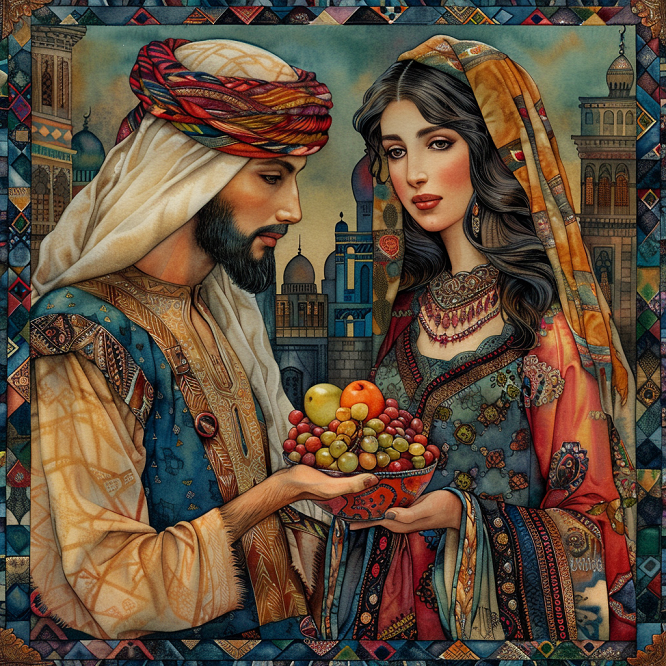
Conclusion
As Lady Anne Blunt’s captivating journey through Nejd comes to a close in her remarkable book Pilgrimage to Nejd, a culmination of vibrant encounters and deep insights into the Bedouin society emerges. Through her vivid recounting of experiences, Lady Anne weaves a tapestry of cultural richness, human connection, and historical significance that leaves an indelible mark on the reader.
One of the key takeaways from Lady Anne’s pilgrimage is the profound significance of the blend of culture and technology in Nejd. The harmonious coexistence of traditional Bedouin customs and emerging modern technology serves as a mirror to the evolving nature of the region during that era. The presentation of a telephone by the Emir symbolizes a bridge between past and future, tradition and innovation, offering a glimpse of the intricate societal changes underway in Nejd.
Furthermore, Lady Anne’s personal thoughts on the inspirational figures she encountered in Nejd add a layer of human connection to her narrative. From the proud mother Beneyeh to the insightful Zehowa, from the esteemed Emir to the enigmatic Nassr ibn Hezani, each individual she encountered left an indelible mark on her journey. Their stories, mixed with hers, form a collective narrative of shared experiences, mutual respect, and cultural exchange that transcends geographical and historical boundaries.
In the end

